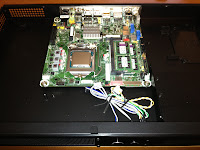As a teleworker, I soon discovered that a home office is not the ideal workplace for everyone. Even without spouse/kids, I'd find myself breaking up my day with various non-work errands and chores. This can lead to a pattern of "making up work time on nights and weekends" that may or may not actually happen. The disciplined approach of working a mostly contiguous day can become a slippery slope to cabin fever. In 2010, a trusted friend approached me with the idea of sharing costs on a telework space. I leapt (inside joke) at the chance.
This is Comcast country, so we split the bill on business class service with static IPs for remote access to our office network. I installed a small Intel Atom-based firewall/router running pfSense to handle network chores. Over time, I added static routes and dnsmasq config to allow persistent access to our respective company's networks via Linux-based VPN routers running under virtualization.
Alas, things change and paying for an office no longer makes sense. Being under contract with Comcast, I decided to move the business class service from office to home. The tech did the install yesterday, and I got my router working with the Comcast gateway today. So right now I have both residential and business networking.
MacBook Pro => wireless router => Comcast residential modem => Internet
MacBook Pro => wireless router => Comcast business class gateway => Internet
I'm still weighing whether I'll cancel my residential service entirely or keep it just for TV. Bundled pricing being what it is, Comcast seems to want me to cancel. Maybe (against hope) I can talk to a Comcast CSR who appreciates my dilemma.
As for my own networking setup, wireless routers are getting really powerful and pfSense is overkill for most home networks. This means out with the pfSense box and in with the ASUS RT-N66U wireless router running Tomato Shibby firmware. The N66U is what I would label prosumer quality, while the Tomato firmware makes this suitable for small office setups. Having used various stock and open firmwares over the years, this is really a thing of beauty when running on a full-featured router.












